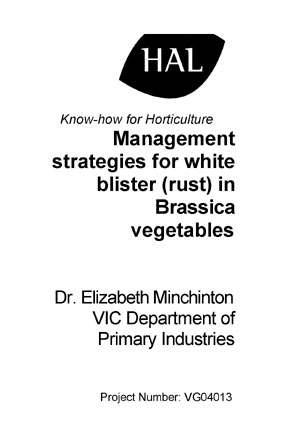|
|
The white blister epidemic of 2001/02, which spread Australia wide, had a dramatic impact on Brassica production nationally, resulting in an industry dependent on year round fungicide applications to control foliar and head diseases. The objective of this project was to identify management strategies for white blister on seed, seedlings and in the field. Investigations concentrated on the evaluation of cultivar susceptibility, fungicides, a disease predictive model, a seed health test and a rapid molecular test to differentiate races of Albugo candida on vegetable brassicas.
Major outcomes included the identification of broccoli cultivars less susceptible to white blister by up to 100%, relative to the susceptible cultivar Greenbelt in national trials. The cultivar Belstar was consistently the least susceptible, but slower to mature in commercial production. Chemical options for white blister control on seed, seedlings and field grown broccoli were explored using various timings of systemic, protectant and soft chemical options (those having a short or zero with-holding period). Evaluation of a disease predictive model Brassicaspot TM, linked to a weather station saved up to 8- 10 protectant sprays while the �Best Bets� program (which consisted of systemic sprays at 5 weeks and at button stage) saved up to 9 protectant sprays per crop relative to copper based calendar spray programmes, while providing equivalent disease control. White blister appeared in crops about 7 days after a high risk period, which correlated with the model. A measure of profitability, determined by a cost benefit analysis of chemical management practices for white blister, indicated that no single management practice was consistently superior. Less susceptible cultivars were generally more profitable than more susceptible cultivars. Race studies found no evidence to indicate that isolates from C. bursa-pastoris and B. rapa varieties identified as AC 4 and AC 7, respectively, contributed to the epidemic on broccoli. But B. nigra was more susceptible to races AC 7 and AC 9 than in overseas studies, suggesting that local isolates have higher virulence on that host. The researchers acknowledge the financial support for this project from Horticulture Australia Limited (HAL), AUSVEG, the Federal Government and the Department of Primary Industries, Primary Industries Research Victoria. The authors thank the the members of the advisory groups, Daniel Gleeson, James Kelly, Kon Koroneos, David McDonald, Mark Milligan, Rob Nave, Matt Newland, Dale O’Connell, Karl Riedel and Ian Willert for their valuable contribution to this project. The authors thank Dr Hoong Pung of Peracto and Dr Kristen Stirling of Department of Agriculture and Food WA, for managing field trials in Tasmania and WA, respectively. |
||||||||
|

